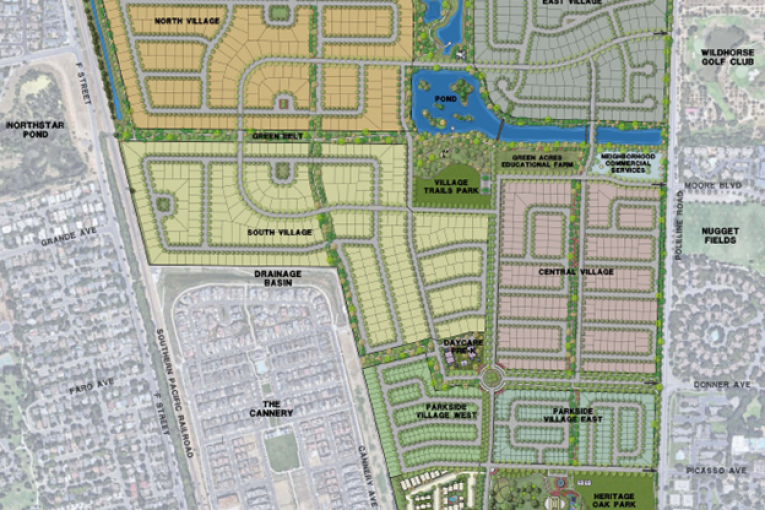
Concerns include toxics, traffic, floodplain, unaffordable housing, unsafe bike/pedestrian access, and infrastructure costs issues
By Eileen M. Samitz and Pamela S. Nieberg
There can be no assumption that the Village Farms site is safe for development. It is surprising and disappointing to see a recent article attempting to dismiss the significant concerns that have been raised in the past and recently regarding toxics contamination from the former City landfill site and the former City sewage treatment plant which are immediately adjacent (north-east) to the Village Farms property.
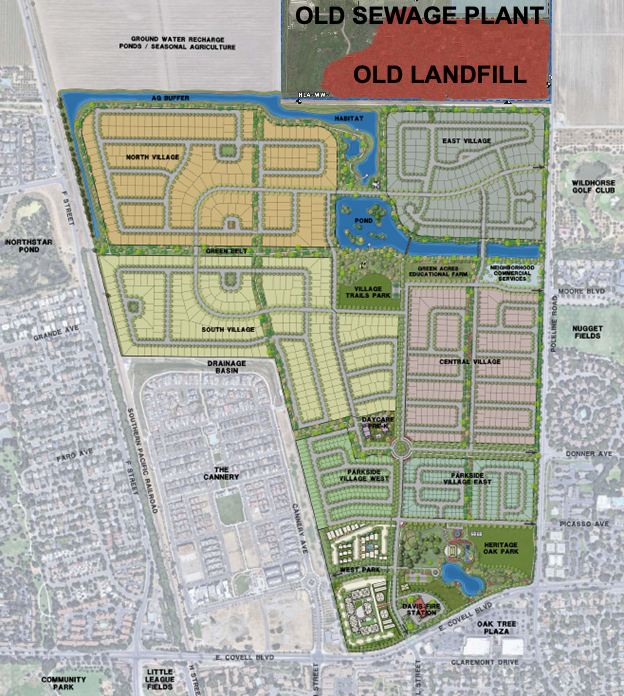
The sewage treatment ponds are inactive but still present. Many concerns were raised regarding this issue during the previous proposal of Covell Village on this same land parcel in the Draft EIR, but were not adequately addressed including insufficient monitoring of the area for contaminants from the old City landfill site. For instance, there were only 3 monitoring wells for testing of the former landfill which encompassed 31 acres of the 186-acre landfill/sewer treatment plant site (WKA Figures 1, 2, and 5), and 3 wells on site on the 390-acre Village Farms site and one well in the Wildhorse vicinity on the east side of Pole Line Road.

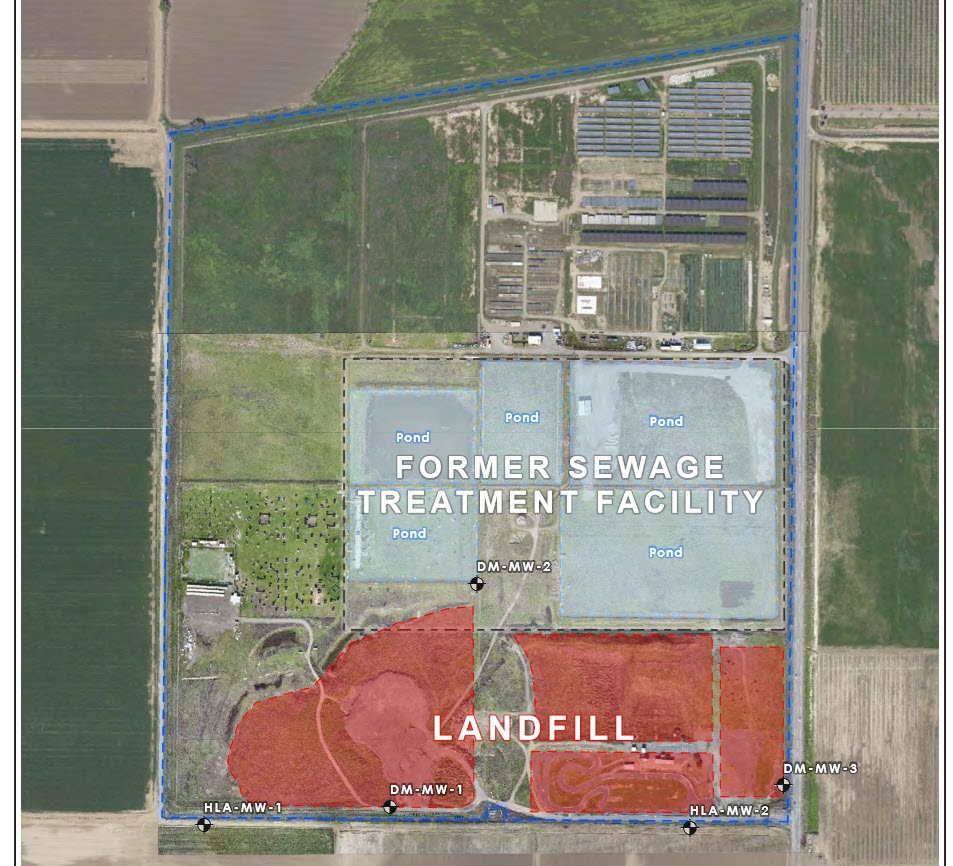
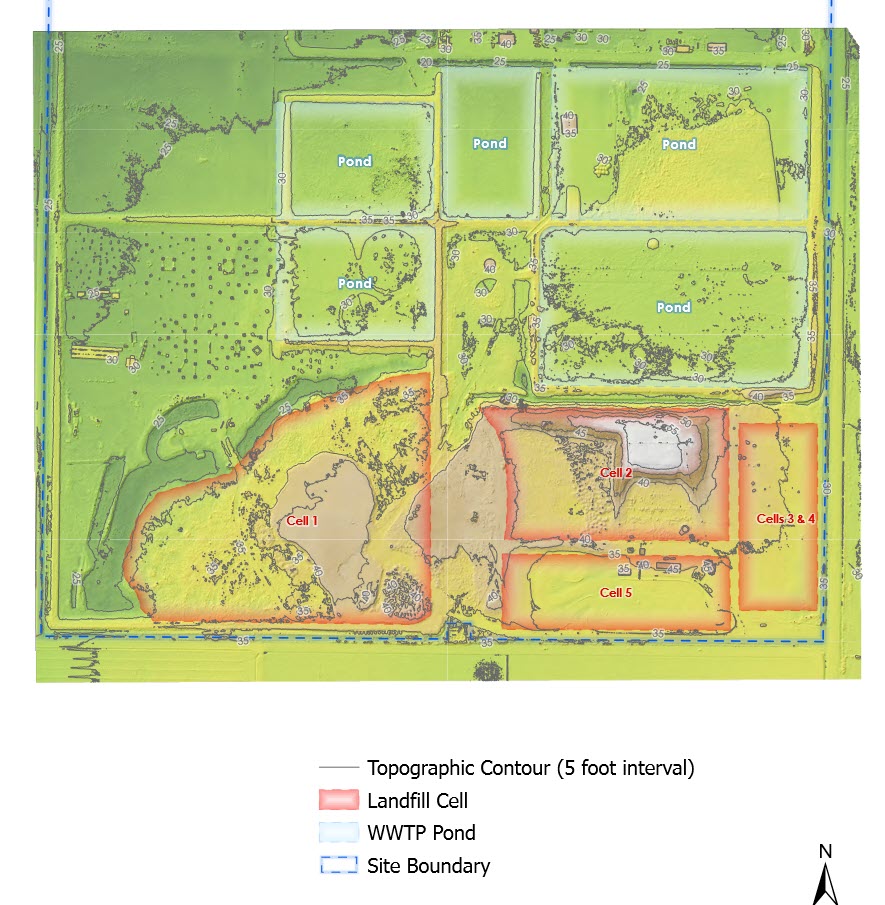
Concerns regarding the toxics on the Village Farms site have been raised before. For example, data from previous toxic studies done on this area revealed Maximum Contaminant Levels (MCLs) per state drinking water standards were found on the adjacent former City landfill for some of the contaminants including vinyl chloride, which is a carcinogen. Toxic chemicals including vinyl chloride were also found on the Village Farms site during the previous Covell Center proposal in 1997 by Dames and Moore. Yet, no clean up actions were ever taken on the former landfill site, or on the (then) Covell Center site. Only monitoring was done which was recommended to be performed four times a  year. Initially testing was done quarterly, but it was reduced to only one time a year as time went on and was limited to testing only for volatile organic chemicals. However, Wallace and Kuhl reported on two samplings taken in 2019 which included testing for other toxic materials.
year. Initially testing was done quarterly, but it was reduced to only one time a year as time went on and was limited to testing only for volatile organic chemicals. However, Wallace and Kuhl reported on two samplings taken in 2019 which included testing for other toxic materials.
There are multiple problems regarding the Village Farms site, including and not limited to the toxics concerns, but the following are just some of the relevant facts:
1) This adjacent former City landfill site was unlined, therefore there was no barrier to prevent leakage from 300,000 tons of trash dumped which included commercial and industrial, as well as residential trash dumping. So, all kinds of toxic substances were dumped at this former City landfill site for decades and have been seeping into the underground water, including vinyl chloride, a carcinogen. Vinyl chloride, among other toxic chemicals, was also documented on the Village Farms site in the Dames and Moore study in 1997 from the previous Covell Center proposal EIR on the same land.
2) The Dames and Moore 1992 report stated that a groundwater SWAT (Soil and Water Assessment Tool) for the landfill site was done and they found that vinyl chloride was found which exceeded the MCL (Maximum Contaminant Level) allowed by the state drinking water standards. Selenium, nitrate, chloride and total dissolved solids also exceeded the MCLs. Vinyl chloride was also found on the Village Farms site. Other toxics found included halogenated and aromatic volatile organic compounds VOCs including trichloroethylene, 1,2-dichloroethene, 1, 2-dichloropropane, 1,4-dichlorobenzene, and tetrachloroethene in down-gradient wells including two wells on the (now) Village Farms site. It is notable that vinyl chloride and other volatile chemicals can easily be lost from samples if the samples are not quickly and carefully sealed. Otherwise, the volatile chemicals dissipate, giving a false negative result.
3) The former landfill site used open burn pits for trash for several decades, including whatever toxics were in the unsorted trash.
4) No major clean-up has been done of the former City unlined landfill site. There has been inadequate monitoring reduced to only once a year on only 3 wells on the large landfill site, 3 wells on the 390-acre Village Farms site, and 1 well on the Wildhorse vicinity site just east of Pole Line Road.
5) It is notable that the former City landfill site was also used as a police firing range and so there is plenty of lead from the ammunition on the site.
The concern here is that if the City allowed the Village Farms site to be developed without significantly more toxics analysis, there could be serious consequences. Toxics on the site could result in residents becoming sick from the toxics, the City would be liable for approving the project and could be subject to lawsuits. Ultimately, Davis residents would wind up paying for that lawsuit via their taxes. Why would the City allow such risk to the community by allowing this site to move forward without far more toxics analysis?
The City’s monitoring, so far has focused primarily on the former City landfill site, not the adjacent Village Farms site. Toxics move in groundwater. While Wallace and Kuhl’s report states that the waterflow when they tested it appeared to be going north, all of the Dames and Moore studies data documented that the flow was south and south-east towards the (now) Village Farms site. This is why the 3 monitoring wells were placed on that property. Ground water flows can periodically change direction due to various factors, including changes in rainfall. Therefore, it is unwarranted to assume that the groundwater flow has changed permanently in a northernly direction.
Regarding the Geocon references, these consultants were not hired by the City, but by the same current developer. Geocon’s reporting on the toxics was dismissive and questions addressing concerns were not adequately answered during the EIR process. These consultants even recommended that the monitoring wells be moved off the (now) Village Farms site in 2004.
Regarding the 2020 Wallace and Kuhl and Associates report, it stated:
“WKA researched the Central Valley Regional Water Quality Control Board files and found that the landfill monitoring activities were not being conducted pursuant to Waste Discharge Requirements and that the shallow groundwater monitoring activities were not being conducted under a Monitoring and Reporting Program.”
The same Wallace and Kuhl consultants pointed out that they had not gotten any summary information from the City regarding the monitoring:
“The City’s activity is limited to the sample collection and contracting for laboratory analyses. The City has prepared no summary tables for the analysis results and prepared no reports of findings.”
In addition, the Wallace and Kuhl report includes significant disclaimers such as:
“No recommendation is made as to the suitability of the property for any purpose. The result of the investigation does not preclude the possibility that materials currently, or in the future, defined as hazardous are present on the site.”
Furthermore, this Wallace and Kuhl report was done before there was any public knowledge that the adjacent Village Farms site was being considered for residential development. A residential development site, obviously, would need a much more thorough analysis for toxics for safety reasons, as compared to a dormant landfill site. Neither the old landfill site nor the proposed development site has had any significant clean-up actions.
How many people would be willing to spend hundreds of thousands of dollars for a home on a site immediately adjacent to an unlined former landfill site and sewer treatment plant which has not had any major clean up, nor had an adequate toxics assessment which could result in health impacts to them and their families?
The City has a responsibility to require far more toxics analysis than the minimal information they have for the 390-acre Village Farms site before considering a huge housing development proposal for the site. Housing at this site without further analysis of the potential toxics issue could result in negative consequences to the future residents and to the community as a whole, due to the toxics and legal liability which would become a financial liability. This analysis needs to be done before this project is even considered for development.
In addition to the toxics concerns, the Village Farms site has a multitude of other problems including:
1) A large floodplain of roughly 200-acres covering at least half of the project site. How many people want to risk flooding issues to buy a home at this site? Further, California State law now stipulates that it will no longer financially bail out flooded sites on which city’s approve development, unlike prior to this policy. Also, the flood plain span would include areas over the toxic’s leakage from the former landfill site onto the Village Farms site.
2) The Village Farms site has an active major gas pipeline underneath it running north-south down the middle of the property and through the former landfill site (see figure 4.10-1). How old and in what kind of condition is this gas pipeline? Who would be responsible if this gas line ruptured if it is not properly evaluated and secured for safety? The last thing we need is a gas line explosion disaster such as that which tragically occurred in San Bruno in 2010.
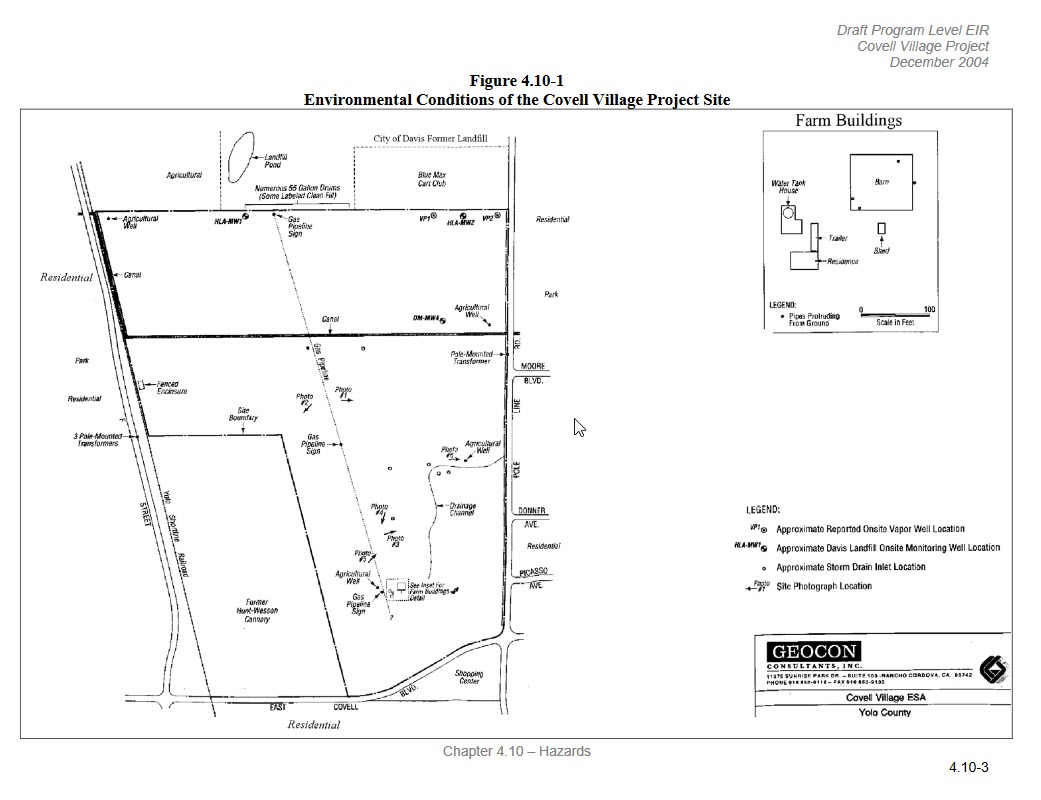
Regarding the P, G and E pipeline, it is notable that the Covell Village EIR states that: “Development in this right-of-way (including landscaping) is subject to PG&E approval, and no building construction may occur on the easement because PG&E requires access to the line for general maintenance and monitoring. Greenbelts, parks, and surface streets are the appropriate uses above such an easement.” Yet, the Village Farms project appears to have homes planned to be built on top of this extensive pipeline in some areas.
3) Unmitigable traffic and circulation impacts due to this Village Farms location at the heavily impacted Covell Blvd. and Pole Line Road intersection were bad enough in 2005 when Covell Village was proposed. But the traffic impacts have multiplied with many cars from Woodland including the Spring Lake project. The traffic there is terrible now. If 1,395-unit more units from Village Farms were added in the Covell Blvd. and Pole Line Rd. vicinity, it would be gridlock for extended periods of time. Traffic would be dramatically delayed trying to get through this intersection, and through the Pole Line Rd. and Covell Blvd. streets. Plus, cars would use other alternative routes affecting traffic and circulation in the adjacent neighborhoods, such as L Street.
4) Over 60% of the Village Farms housing would be large housing units which would not be affordable to young families and average workers. Village Farms is proposing a massive amount of unaffordable housing which could wind up sold to people moving from the Bay Area who can afford these “McMansions.” This does not help provide housing needed for our local families and workers and to help get more children residing in Davis to attend our grade schools which have diminishing student populations. Davis needs small housing units on small lots, not a lot more McMansions.
5) Lack of safe bicycle/pedestrian access issues would be a serious problem on Covell Blvd. and F Street for this enormous project. There is no ability to have safe access over, or under Covell Blvd. from this project site for any children/or bicyclists or pedestrians, trying to cross Covell Blvd. near Pole Line Road. This area has massive traffic but also high-speed accidents which have happened too often.
6) Access over or under the F St. railroad tracks is a fairy tale. Even if it could happen, the cost of this infrastructure would be enormous, like the project-proposed bike/pedestrian Pole Line Road overcrossing. These infrastructure costs would simply add to the cost of the Village Farms housing units. The same developer, John Whitcombe, promised access over or under the railroad tracks at Nishi five years ago, yet that has not happened. This is because the railroad owners are typically resistant to allowing access over or under railroad tracks for a number of reasons including potential liability issues. This problem was raised during the Nishi 2.0 debate and is the main reason why the Nishi project has not moved forward.
7) Infrastructure costs would be enormous for the Village Farms project and the concern is whether Davis residents would end up having to pay the costs to subsidize the expensive infrastructure needs that this project requires, such as the proposed overcrossing over Pole Line Road.
While it may not be obvious, the Village Farms site is in the County, not in the City, therefore it is not infill, it is a peripheral site. The bottom line is that the Village Farms site has many significant problems, as it has in the past, which is why the previous Covell Village version was voted down by the Davis voters in 2005. This Village Farms proposal is no different, except the problems would be even worse, such as traffic at Covell Blvd. and Pole Line Road. which is already seriously congested, and the current proposal is primarily large expensive housing units rather than housing affordable to our workers and families. Furthermore, it would be irresponsible of the City to even consider the Village Farms proposal without doing the in-depth thorough toxics analysis needed first. But given the many problems that the Village Farms site has, it is without question the worst site because it would bring the most impacts and has the worst project design of all the project sites being proposed for development.
For citizens concerned about this project or for more information please email citizens@dcn.org.
Eileen Samitz is a former Davis Planning Commissioner and served on the City of Davis 2001 General Plan Update land use committee and the subsequent Housing Element Update Committee.
Pam Nieberg worked in the field of toxicology for 38 years. She founded and served as president of the Frontier Fertilizer Superfund Oversight Group (FFSOG), a community group working for 29 years with USEPA on the Frontier Fertilizer Superfund Site in Davis after USEPA designated it as a federal superfund site.

As Alan Pryor discussed earlier this week, the likelihood of contamination of the Village Farms site is relatively low. In fact, it seems that Wildhorse is now at greater risk. Has anyone tested those neighborhoods or conduced an epidemiological study on any apparent increased risks? In any case, the landfill has complied with SWRCB regulations for closed landfills.
An important question is whether those parcels are truly exposed to flood risk. FEMA recently (November 2022) revised the designations for much of North Davis for a variety of reasons. Having run through those fields for decades now, I have see very little standing water, unlike the fields in northwest Davis. The flood risk appears to be minimal. (And studies show that California has a much lower actual flood damages and overpays to the federal flood insurance program.)
PG&E’s gas pipeline doesn’t just end at Covell–it runs through inhabited Davis. If there’s a risk, many of our citizens are already at risk. If there’s concern about that risk, it’s much more important to address the existing one before delving into what might be a new one.
Traffic congestion is now no longer a CEQA issue. Instead VMT is key, and this project should reduce VMT by bringing households closer to employment in Davis. It should also reduce traffic down Poleline from those who commute from Woodland into Davis.
The points about Covell/Poleline and the Covell Bridge seem to be arguing that we should never get out of our cars to walk or bike. Instead, the solutions are to redesign the intersection. The bridge is now much more usable by bikes.
The development fees (which I had a hand in designing when I was on the Utilities Commission) will cover infrastructure costs so current residents will not see an increase in rates.
Actually, toxics contamination is not something that can be left to “likelihood”. This is about the health, welfare and safety of the residents and the environment. The issue here is that there has been no clean up despite the fact that toxics like vinyl chloride, which is a carcinogen, leaked from the unlined landfill site have been documented on both the landfill and the Village Farms property. Further, not nearly enough testing has been done with only one annual testing from only 3 wells for the 390-acre site. That’s just absurd.
Regarding the floodplain FEMA floodplain map is actually bigger now on the Village Farms site, and again, trying to dismiss it with “likelihood” with the swings in our climate is not good planning.
The P,G and E pipeline runs underneath streets south of the Village Farms site, not under houses, like the Village Farms project layout. This is the major high-pressure gas pipeline that runs north-south in Davis and for the developer to try to build on top of the pipeline does not make much sense.
The issue about Covell and Pole Line is that you can’t build an overpass over it or under it. So, it is a lack of safe access problem. The issue about the proposed overpass over Pole Line Road is that it is a very expensive piece of infrastructure and the question is, will the developer be paying for all of it, or will the City be put on the hook to help subsidize it with developer trying to justify the City needing to cover some portion of the costs? On the other hand, even if the developer pays for it, the cost then gets passed on to significantly increase the cost of the houses.
Furthermore, there are other very expensive infrastructure costs that the Village Farms project will not be paying for like the proposed new fire station on the site and the long-term staff salaries, operational, and maintenance costs, but then the City and therefore our Davis residents will be paying those costs. The bottom line is that enormous infrastructure costs to the community would come with this Village Farms project.
So, the point here is that this Village Farms project has a plethora of problems, which is why it is the worst project out of all the proposals.
As long as the proposed development complies with all relevant environmental regulations, there are no actual environmental reasons why this development can’t be constructed.
I find this argument to be another classic “what if” NIMBY tactic. We can bring up “what if” scenarios all day. [edited]
Why don’t we let the developer, government officials and prospective residents make that decision?
[edited]
I have tried to duplicate the commenter’s original block quote format but every time I try, it comes out different than expected. So, instead I will bold the previous block quote text, italicize the commenter’s comment and then my response.
From article: Actually, toxics contamination is not something that can be left to “likelihood”. This is about the health, welfare and safety of the residents and the environment.
Walter Shew:“As long as the proposed development complies with all relevant environmental regulations, there are no actual environmental reasons why this development can’t be constructed.
The issue here that is there has not been adequate testing to assess the contamination. The Wallace and Kuhl report stated that the monitoring was not in compliance with the state regulations. Further, they also stated they were not given sufficient information of what had been done regarding the testing from the City. This was covered in the article.
From article: Regarding the floodplain FEMA floodplain map is actually bigger now on the Village Farms site, and again, trying to dismiss it with “likelihood” with the swings in our climate is not good planning.
Walter Shew:“I find this argument to be another classic“what if” NIMBY tactic. We can bring up “what if” scenarios all day. The climate swings could also affect the home you reside in Eileen.”
You can choose to ignore important factors and allow poor planning, or instead embrace good planning principles like, “don’t build on enormous flood plains”, which frankly is common sense. Look at what happened in Natomas with the flooding. I think Sacramento has learned its lesson after that bad mistake and costly debacle. It is foolish and counter-productive to not learn from mistakes like this because it is the home owners, City and all the tax paying Davis residents that get stuck with the consequences, including the damages and enormous costs caused by the flooding. Also, it looks like your main objective here is to post insults, not understand and discuss the issue.
From article: This is the major high-pressure gas pipeline that runs north-south in Davis and for the developer to try to build on top of the pipeline does not make much sense.
Walter Shew:“Why don’t we let the developer, government officials and prospective residents make that decision?”
I think you are being a bit naïve to believe that everything will be “just fine” relying on the developer and government to address these serious issues. The problems wind up occurring if not raised and addressed right away, otherwise they occur and are then dumped onto the City and residents to pay the price of resolving them. It is citizen pressure more often than not that brings these issues to the forefront advocating to resolve the problems rather than ignore them. It is important to be proactive to avoid the problems instead of having to deal with what is always a costly and difficult problem to resolve later, if you allow the problem to occur.
First off, my last name is spelled “Shwe”. Now let’s dive into the details.
As I have previously stated, the ultimate authority in this matter will be city, state and federal regulators. That’s the jobs of regulators, not a handful of Davis residents.
Using your logic, quite a few other parts of California should never been developed besides Natomas. Natomas isn’t the only part of California devastated by flooding during the past year. Similar logic could also applies to California regions at highest risk for earthquakes, including parts of the Bay Area and southern California. Using your logic, many other parts of the United States should have never been developed either. One state that immediately comes to mind is Florida. Florida has been regularly pummeled by hurricanes. It’s not like Florida hurricanes were any secret.
[edited]
I am a proud YIMBY, “Yes In My Backyard”. I welcome with open arms new housing in Davis because there has been a severe lack thereof as David has previously alluded to.
IMHO, you are the naive one regarding the pipeline issue. Are you Eileen a gas pipeline or safety expert? Governments employ and consult with experts to sort out these very types of environmental and safety issues. That’s where our tax dollars in part go to. Who says that government authorities have concluded their review of Village Farms? According to the City website, this proposal is listed under “Major Development Projects – In Process and Under City Review”. This proposal could still either be officially rejected by the City or withdrawn by the developer before it ever appears on the ballot. The best way to express your concerns is to communicate with City officials directly, not on a website that most Davis residents likely don’t know exists.
Our daily life is about likelihood of exposure to toxic contamination (and other hazards such as flood risks), as we’re told thanks to Prop 65 warnings. We inhale benzene, a potent toxic contaminate every time we refuel our cars (which is why I walk away from fuel nozzle when I refuel.) And there are many other examples. This is not to say that these risks should be ignored, but they must be weighed as to relative importance. One important way to assess that is to see if Wildhorse residents are experiencing increased mortality and morbidity because Alan’s analysis indicates they may be increased risk. We certainly haven’t heard of such hotspots in that neighborhood, so the burden of proof falls on those who need to show a positive effect. (It’s not logically possible to prove a negative which is why hypothesis testing is set up the way it is.) One further point–closed landfills in the West are a substantially less risk than in the East because of vastly reduced rainfall. The national standards are set for the more populace East.
These flood maps for Davis were greatly revised with reduced flood risk. And as with the Cannery, building a berm sufficient to protect against encroachment from the north will be an easy task with the irrigation ditch running across that property.
https://www.cityofdavis.org/home/showpublisheddocument/17483/637848536059770000
https://www.cityofdavis.org/home/showpublisheddocument/17479/637848534695870000
Cost allocation of the fire station will be an important discussion. It will benefit many surrounding the development in reduced call times. Staff costs are not “infrastructure”–they are ongoing operating costs, and there has been debate about the fiscal effects of new development. Actual additional infrastructure costs are covered by the developer. Note that if infill projects had similar population increases, they also would trigger the need for a new fire station, perhaps in a different location. So this is not unique to a new project–it’s a feature of complying with RHNA quotas.
And it still looks like you are arguing against bike and pedestrian access by anyone east of the railroad and Poleline to the rest of the city. Village Farms will be a small proportion of the total population on the eastside (at least 20% of the city.)
The solution to the PG&E line is quite simple if you’re willing to accept existing PG&E lines running down the middle of the street–align a street to run over that line. It will be much more accessible for PG&E anyway.
” Natomas isn’t the only part of California devastated by flooding ”
There was no significant flooding in Natomas this year despite being among the wettest years on record. FEMA has generally over estimated flood risk in California, and Californian’s pay too much in flood insurance. (See studies by Resources for the Future and others.)
So I live in a house in mace ranch which is within 100 yards of an actual superfund site. As I understand it, the contamination plume extends below the houses in mace ranch, including mine.
How is it that homes can be safely built next to a superfund site, but NOT next to an old dump which (I would assume) poses much less of a threat?
When the homes were built in that area of Mace Ranch the extent of the contamination was not fully known. USEPA did further studies revealing the extent of the contaminantion, it was then declared a federal superfund site and USEPA began clean-up efforts.
Tim still resides there. If he felt it was no longer safe, he would have probably moved by now.
Yes, because there has been a very effective clean up process in that Mace Ranch area.
I don’t think the ground directly beneath Tim’s residence has been thoroughly cleaned up. To do that would probably mean either drilling though portions of his flooring and/or tunneling beneath his home. I would imagine either option would require all of the occupants to temporally move out of the residence.
Well what can be said is that the testing done in that area has been frequent and from many monitoring wells which is indicating that the clean-up is helping. But the lesson that needs to be learned from this situation is that this is precisely why adequate testing needs to be done first on any land which has had toxics contamination before any consider of developing it.
Regarding Walter Shwe’s 5/21 2:35pm comments:
To begin, my apologies for the name mis-spelling.
On the first point: One cannot rely on “regulators” including the City because that clearly doesn’t always work as exemplified by the fact that houses were built over land with a contaminated plume in Mace Ranch. But it was Davis citizens who stepped up to ask for the City to delay building the houses there until the clean-up was done.
On the second point: The logic of advocating to build on land pummeled by natural disasters is rather odd, but it has nothing to do with the need to do adequate testing for contamination on a site which has had toxics on it including vinyl chloride which is a carcinogen. Perhaps this is unimportant to you but it is a health, welfare, and safety issue regarding residents and the environment. The City needs to not repeat the same mistake they made in Mace Ranch.
On the third point: I don’t claim to be an expert on pipelines but it’s just common sense that you don’t build homes immediately over major high-pressure gas lines intentionally. Further, I would not want to live in a house over a major high-pressure gas line, and think that most people would not want to either.
Finally, again, the bottom line is that this Village Farms project and site has a plethora of problems, and is the worst proposal with worst project plan of all the proposals before the City.